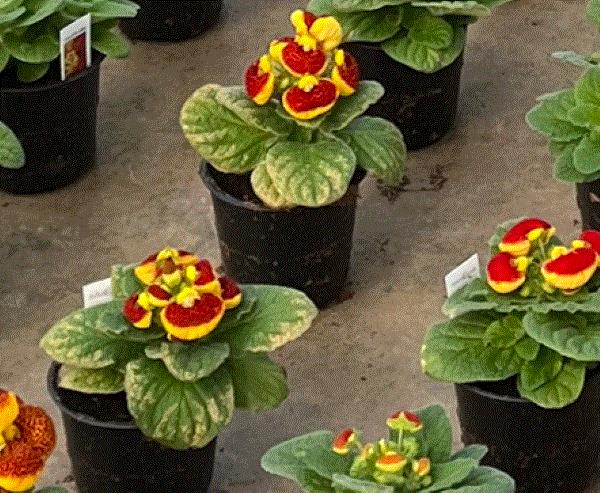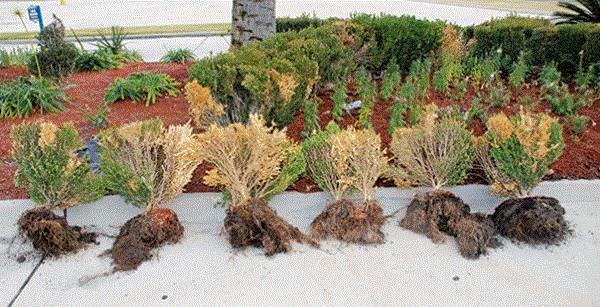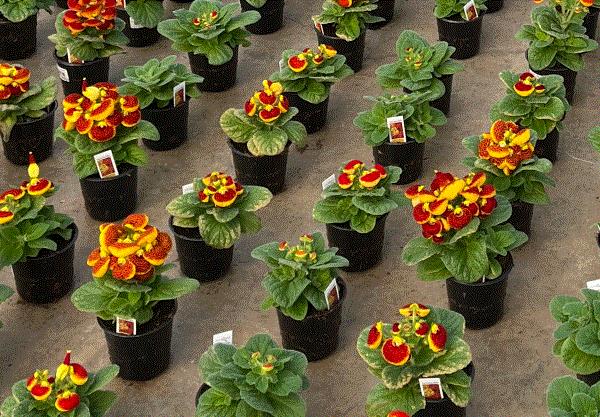What the ... ?
Spring is coming. Some greenhouses have already started their spring crops even if a blizzard is blowing on the other side of the glass or poly. Not just pansies and violas, but also begonia, cyclamen and other crops.
One greenhouse has calceolarias with chlorosis on the older foliage. What’s wrong?

Sanitizing Before Spring Crops
Spring is also the time for sanitizing greenhouses. Sanitation is an important task before starting a spring crop because dirty floors, benches or irrigation lines, and old weeds and debris from last season hide pests and diseases that can spell trouble for spring crops. Need more convincing? Let our own Paul Pilon do the convincing in this GrowerTalks article.
I’m glad to know that some of you are doing or planning spring sanitation. I was visiting growers with Jeff Hermes of Heritage Professional Products last week and folks were ordering Strip-It from Jeff. Whoever you are, kudos!
As Paul mentioned, sanitation involves cleaning and disinfecting. You’ll have to physically “clean” or remove weeds, old plants, debris, media, pots, etc. from the greenhouse. Brush or scrub benches and hard surfaces to remove tough algae, organic matter or stains. Scrubbing is particularly important for wooden benches or surfaces because wood collects more junk and is harder to sanitize with cleaner or sanitizer than plastic and concentrated surfaces.
After cleaning, sanitize. You can start by applying a cleaner or detergent, such as Strip-It (sulfuric acid and ammonium bifluoride as the active ingredients), and let the solution sit on the surface for a few minutes to loosen up tough or tightly bound organic matter.
After you rinse the surfaces with water and get rid of Strip-It residue, you can then apply a sanitizer, such as Green-Shield (quaternary ammonium), KleenGrow (quaternary ammonium), SaniDate (hydrogen peroxide + peracetic acid) or ZeroTol (hydrogen peroxide + peroxyacetic acid). Let the sanitizer solution sit for a few minutes. Go HERE for an article where Tami Van Gaal of GSS Pro talked about the products available for sanitizing various surfaces and irrigation lines.
Here are a couple more articles on in-season sanitation with tips that are applicable to spring sanitation. Go HERE for an article where Raymond Cloyd and Nathan Herrick talked about sanitation for managing insect pests. Go HERE for an article from Bill Calkins where he discussed sanitation with Todd Cavins of Ball Horticultural Company.

Boxwood Dieback is Spreading
Xiao Yang, who heads up the Plant and Pest Diagnostic Clinic at Clemson University, sent out an article about boxwood dieback just before Christmas break. Xiao was alerting us that detection and reports of boxwood dieback, caused by the fungal pathogen Colletotrichum theobromicola, in South Carolina is on the upswing. Even the Governor’s mansion wasn’t spared! It’s likely a similar situation in other southeastern states where the disease has established. The disease has also been detected in New York, Virginia and Indiana.
When the disease was first reported in 2015, folks were wondering what else can happen to the poor boxwood after the ravage of boxwood blight, Volutella blight, phytophthora root rot and other diseases. English, Japanese and Korean boxwood cultivars are particularly susceptible to boxwood dieback. Twigs on affected boxwood just die, with the tan leaves remaining attached to the twigs. When the bark of infected stems is peeled back, you’ll notice the black or discolored tissue under the bark.

Progression and symtoms of boxwood dieback in a landscape planting. (Photo credit: Raj Singh, Lousiana State University.)
To my untrained eyes, the symptoms of boxwood dieback are similar to many other boxwood diseases, particularly Phytophthora root rot and Volutella blight, so it’ll be very important to submit samples to diagnostic labs to confirm the causal agent.
Growers should isolate infected plants for treatment, or even discard the plants, if the disease has been confirmed. Landscape care operators should only plant healthy plants and infected plants should be removed quickly. Pruning off the dead twigs won’t “cure” the plants or stop the disease from progressing. Because this is a relatively new disease, no effective fungicide has been recommended.
Go HERE for a summary of what we know about boxwood dieback and go HERE for a collection of photographs of symptoms and signs.

Answer to “What the … ?”
Although the chlorosis looks like those caused by thrips or spider mites, the calceolarias in this case are suffering from iron deficiency brought on by improper pH.
Media pH in the range of 5.5 to 6.2 should be maintained. Substrate pH above 6.2 could inhibit iron uptake and the resulting iron deficiency can cause chlorosis. The grower fixed the problem by adjusting the pH to the proper range. Notice that the new leaves flushed after the treatment don’t have chlorosis. Success!

I’m not a horticulturist and I don’t pretend to be one, so I’m going to let a real horticulturist tell you how to grow and correct nutrient deficiency in calceolaria. Go HERE for an e-GRO article from Garrett Owen, Josh Henry and Brian Whipker on nutrient management for calceolaria.
Diagnosing Abiotic Disorders
I have to admit, the picture I shared in the “What the … ?” segment was a wee misleading. I only showed you the worst-looking plants instead of the plants around them. If you would've seen all the other plants as in the picture below, you perhaps could guess that it may be some kind of nutritional deficiency or abiotic disorder because of the uniformity of the symptoms on the majority of the plants in the area.
There's been more than one occasion when I helped folks distinguish between abiotic disorders and biotic disorders. Abiotic disorders are the injuries caused by temperature or humidity extremes, nutritional deficiencies or excesses, salt injuries, mechanical injuries, pollution, pesticide phototoxicity, and other environmental factors. Biotic disorders are injuries caused by a living organism, such as an insect, mite, fungus, bacterium, virus or rodent. Abiotic and biotic disorders can produce similar symptoms, such as chlorosis, necrosis, stunting, defoliation, distortion and even death of the affected plants.
You must properly identify whether you're dealing with a biotic or abiotic disorder before you can narrow it down to the culprit that causes the disorder. Proper diagnosis is the result of keen observations, asking the right questions and logical thoughts.
There are a few clues you can use to distinguish between biotic and abiotic disorders. To me, an important factor I must observe during this process is the distribution and progression of the damage. Is the damage restricted to a plant species or a cultivar? Are the symptoms appearing on all the plants in the same area or a few plants here and there? Did the symptoms show up at about the same time on all affected plants or did they appear over time and got worse?
If the symptoms or damage appears on only a small number of plant species or cultivars, generally uniform on multiple plants, and at about the same progression or severity on most plants, then we're looking at an abiotic disorder. Pests or diseases generally affect more species or cultivars, and their damage usually starts in specific groups of plants, but becomes progressively more widespread and severe over time.
If it’s a biotic disorder, you can usually see the causal organisms or the signs. For example, you can see eggs or individual insects or mites on the leaves. Or you might be able to see fungal spores on or around the damaged tissue. Even if it’s a virus, which you cannot see, you might be able to use an immunostrip to test and find out which virus is causing the problem.
Abiotic disorders, on the other hand, don’t show any readily observable signs. You’ll have to go back to your notes on growing the crop to find out if some issues are occurring, such as improper temperature, gas leak, clogged nozzle, poor pH, fertility program, etc. Find out the cause and correct it. An abiotic disorder stops progressing after the cause of the injury has been corrected.
Just a few words to help you start the spring right!




See y'all next time!

JC Chong
Technical Development Manager at SePRO
Adjunct Professor at Clemson University
This e-mail received by 27,847 subscribers like you!
If you're interested in advertising on PestTalks contact Kim Brown ASAP!